 The Major, or Motoko Kusanagi, is the protagonist of each incarnation of the Ghost in the Shell manga-anime-merchadise franchise. If you care to google, “Motoko Kusanagi is“ autocompletes to “a man” and “is hot,” then “in bed with a boy” and “in bed.” For a science-fiction philosophy character named for her military position, we (the audience — although I don’t limit this to those who have experienced the fiction, as the Major is iconic) sure are caught up in thinking about her gender and sexual status. This is part seven of a pan-franchise series (find previous parts here: 1, 2, 3, 4, 5, 6).
The Major, or Motoko Kusanagi, is the protagonist of each incarnation of the Ghost in the Shell manga-anime-merchadise franchise. If you care to google, “Motoko Kusanagi is“ autocompletes to “a man” and “is hot,” then “in bed with a boy” and “in bed.” For a science-fiction philosophy character named for her military position, we (the audience — although I don’t limit this to those who have experienced the fiction, as the Major is iconic) sure are caught up in thinking about her gender and sexual status. This is part seven of a pan-franchise series (find previous parts here: 1, 2, 3, 4, 5, 6).
Issue two of Man-Machine Interface, published in English in the early 2000s by Dark Horse after the 1991-onward six-year serialisation in Japanese by Young Magazine, was the first piece of Shirow Masamune’s cartooning I chanced upon. Oh boy, some actual Ghost in the Shell manga in my bumpkin town comic shop?! The cover (above left) didn’t feature the character design I recognised as the Major, but that’s no big problem, right? Woman-fetish wise, it’s not quantifiably worse than the average Big Two cover of the time.
Perhaps you’ll recall my ambivalence towards the nudity and sexually charged content in Oshii’s Ghost in the Shell, at this point my only experience of the franchise.
I re-read the issues from back then during the course of this Major’s Body project. I read the entire eleven chapters of Man-Machine Interface, over the course of one day, and before I begin discussing the interesting elements of this work as a comic and as a piece in a franchise, I’ve compiled this title’s most egregious examples of the body as an object.
This is not labelled as a fetish comic. It is a fetish comic.
It’s immediately clear Shirow’s “artistic desires” have changed: breasts are bigger, hips are slimmer. Compare the sex scene in the last image above to the original it refers to. This “evolution” affects each of the bodies that Motoko Aramaki uses throughout the comic’s various sequences; their only differentiation is in hairstyle and outfit.
“The Major” is not a feature of this comic. Following the events of the original manga — her fusion with the Puppetmaster — a new life form is in play. This protagonist is a conceptual identity known generally as Motoko Aramaki, made up of multiple bodies, names, hair colours, and tasks. It’s an idea that could be interesting, if it were actually addressed. It’s not. Nothing is. This comic is a shambles.
I have not come by this opinion alone. Goodreads has Man-Machine Interface rated rather highly, just a fraction off four out of five stars, but read the first page of reviews and it’s a cold shower of why? what? why? Common complaints: it’s incomprehensible, nothing happens, there’s so much fanservice that it all gets a bit silly.
You’ve seen the truth of that! But every issue that Dark Horse put out begins the same way:
To begin your professional output with an apology… Shirow. Serious question: are you okay?
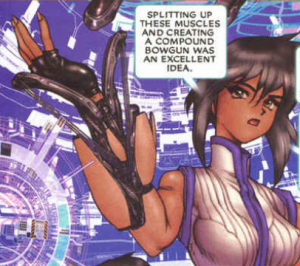 This comic has no trust. The previous manga featured a footnote explanation or two, but here they’re prevalent. Perhaps it’s a very poor translation job — perhaps, but exposition is passionless to the point that it feels pasteurised. Why? Does Shirow not trust his craft? Does he mistrust his audience?
This comic has no trust. The previous manga featured a footnote explanation or two, but here they’re prevalent. Perhaps it’s a very poor translation job — perhaps, but exposition is passionless to the point that it feels pasteurised. Why? Does Shirow not trust his craft? Does he mistrust his audience?
These notes are so chatty I wonder if they aren’t just outreach.
 Occasionally there are glimpses of Shirow’s firm opinions on science and politics that characterised his previous Ghost in the Shell work, but they’re left out of the narrative. Join a message board, Shirow! Go to town hall debates!
Occasionally there are glimpses of Shirow’s firm opinions on science and politics that characterised his previous Ghost in the Shell work, but they’re left out of the narrative. Join a message board, Shirow! Go to town hall debates!
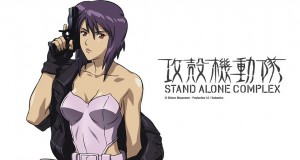 This comic gifts future installments of the franchise with: the Chroma character design (seen again in Stand Alone Complex episode 9, The Man Who Dwells in the Shadows of the Net – CHAT! CHAT! CHAT!), design elements (above) which seem to have informed the nipple-shaped bustier of Stand Alone Complex (right), and… that’s it. As far as I could tell, that’s it.
This comic gifts future installments of the franchise with: the Chroma character design (seen again in Stand Alone Complex episode 9, The Man Who Dwells in the Shadows of the Net – CHAT! CHAT! CHAT!), design elements (above) which seem to have informed the nipple-shaped bustier of Stand Alone Complex (right), and… that’s it. As far as I could tell, that’s it.
This comic is extremely hard to read for several reasons. Shirow used computer graphics for much of the background work. All new techniques! Possibly too new; three-dimensional modelling interacts with the brain in particular ways. It “looks deep”, as it’s supposed to, but in a sequential, panel-based medium it looks TOO deep. This art style is problematic in the way that the average photo-comic is: it’s aggressively full, asymbolic, “too real” to work as a visual metaphor. What the heck am I supposed to do with this, as a single panel? Press play?

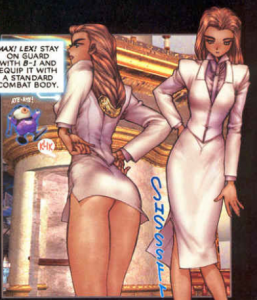 Man-Machine Interface is bad comic art because it forgoes communication for rubber cheesecake at the first chance. It’s bad comic art because it forgoes communication even when it could coexist with masturbatory material. This panel to the left: That skirt grew from short to long in the time that passed as the left image of Motoko Aramaki gave way to the right. Does the art tell you this? Does the overlaid sound effect pick up the illustrative slack? It’s bad comic art because we all remember rubberball Catwoman and
Man-Machine Interface is bad comic art because it forgoes communication for rubber cheesecake at the first chance. It’s bad comic art because it forgoes communication even when it could coexist with masturbatory material. This panel to the left: That skirt grew from short to long in the time that passed as the left image of Motoko Aramaki gave way to the right. Does the art tell you this? Does the overlaid sound effect pick up the illustrative slack? It’s bad comic art because we all remember rubberball Catwoman and 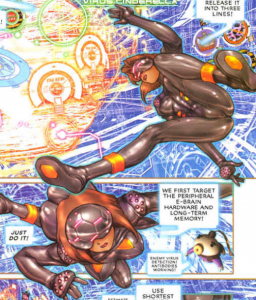 3d Manarawoman.
3d Manarawoman.
It’s bad comic art because it’s boring and because I don’t understand whether it’s supposed to be erotic, or uncomfortable, or both, or neither. I don’t understand if Shirow is trying to communicate something about cyberbodies, or organic bodies; if he’s thinking of this multi-replicated body as just “a woman” or as specifically a cyberwoman which he treats differently on account of it being a product of science fantasy. Should I look into his galgrease output? I just GIS‘d that term, and now I feel bad. Are those women supposed to be human, posthuman, or transhuman? Wiki says women depicted often look “greased,” which sounds like “intentionally human” to me. Does the creator of Ghost in the Shell retain any interest in the thematic questions it inspired?
 There’s no room here for me to think. I’m packed in with these limbs too tightly. Their shine’s begun to hurt my eyes.
There’s no room here for me to think. I’m packed in with these limbs too tightly. Their shine’s begun to hurt my eyes.
The first issue starts with a naked nippleless idol. The scene changes to a military subordinate’s outlined ass and fiddly-done hair as she kneels, in uniform, before several old men.
We meet the protagonist in her most familiar, Major-like guise, bigger breasts, windblown and detailed crotch and cheeks. Sometimes glossy red lips, sometimes not. Surrounded by and engaged with a line of weird donut-mouthed suckling piglets. I’m surprised Shirow never drew them all latched onto her. Sex lampreys. Fuck squelch slop. Camouflage “panties”.
A fleeting moment of potential — law regulating high-function bodies! Human rights! Interesting! — turns into something harmful: lampshaded exploitation. The character “knows” how she’s being looked at, which allows the reader or creator to pretend she and they are in it (“it” being the observation of her body parts) together.
Shirow is quite clear: he wanted to draw her knickers, so he decided she would wear some. This is not philosophical exploration of the future of prosthetic and/or digitised humanity. This is scuzz. It happens again later, when things turn monochrome for whatever reason. I’ve created a dramatisation of what I imagine must be the thought processes involved:
Artist, sweating: Look, she’s a real character who exists through some sort of fiction portal! I’m not in charge of my creative processes! I’m just reflecting what happens in this imaginary other world!
[Drawing faster, licks lips] I’m ACTUALLY just representing the fact that people who perv on her will get in trouble with her, because she’s so competent and can take care of any business.
[Artist winces expressively] like woah okay lady you’re the boss!!! She’s such a–

It’s self-congratulatory, disingenuous, and in opposition to “storytelling.” It takes a selfie with the fourth wall. It’s a sign of somebody doing badly at their craft. It’s often a sign of somebody doing badly at being part of the human community; here we see Chroma being manhandled by larger, rough, male-coded characters, so her breasts bounce, as she looks into our eyes and has a lovely time.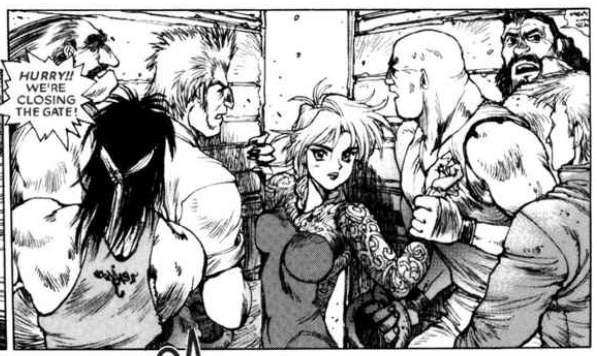
Or this sequence below, using voiceless brown bodies, where the captions approach parody. It’s enough to make you vomit up a bee.
Did you ever think about how cute-sexy you might appear while you’re shitting in the morning? Shirow has that covered.

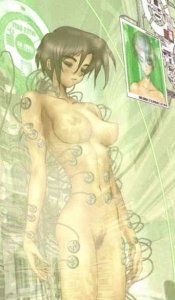 Nearing the end of this comic, I turned the page onto a tube full of a nude unconscious person. We all know the score on this one. X-Men, Dark Angel, The Matrix, etc., etc. Venture Bros, even — a parody which aims to cram in all the familiar beats! We understand nudey tube people. Here’s a thing: when was the last time this image included pubic hair?
Nearing the end of this comic, I turned the page onto a tube full of a nude unconscious person. We all know the score on this one. X-Men, Dark Angel, The Matrix, etc., etc. Venture Bros, even — a parody which aims to cram in all the familiar beats! We understand nudey tube people. Here’s a thing: when was the last time this image included pubic hair?
This practically knocked me out of my seat. Pubic hair? Pubic hair? Pubic hair? Look through all of the images in this post alone, never mind the attitude towards body hair in pop culture at large, and tell me again: who among us expected pubic hair? Did even Shirow overdose on depilation? Did a light smattering of pubes start to seem new? Innovative? BOLD?
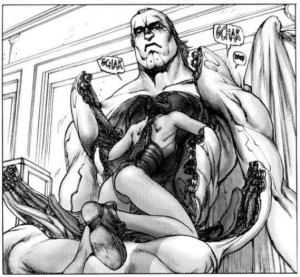 What the hell is going on? Suddenly after years of polished, rubberised cyberflesh, a little pubic hair for spice? Suddenly after chapters upon chapters of latex miniskirts and asshole-deep jumpsuits comes full-coverage traditional dress… blown up by the wind to reveal toned, naked thighs. Because titillation is all that’s keeping this mangaka’s ghost tethered to our disgusting physical world? The later chapters briefly include some stuff that starts to get only the tiniest, slightest bit explorative (above left). It feels like a tragic loss to the comic. Look what you could have been doing, man! Investigating bodies and gender! Course, this mini-sequence also corsets, crotch-shots, and strings up a childlike girl-body, so I cannot recommend even that.
What the hell is going on? Suddenly after years of polished, rubberised cyberflesh, a little pubic hair for spice? Suddenly after chapters upon chapters of latex miniskirts and asshole-deep jumpsuits comes full-coverage traditional dress… blown up by the wind to reveal toned, naked thighs. Because titillation is all that’s keeping this mangaka’s ghost tethered to our disgusting physical world? The later chapters briefly include some stuff that starts to get only the tiniest, slightest bit explorative (above left). It feels like a tragic loss to the comic. Look what you could have been doing, man! Investigating bodies and gender! Course, this mini-sequence also corsets, crotch-shots, and strings up a childlike girl-body, so I cannot recommend even that.
When I was little, my friends across the road had a Barbie dollhouse. The only one in the village. They had all the special Barbies, too; they had a Prince Eric! They had rollerblading Barbie. They had bicycle-riding Barbie.
Bicycle-riding Barbie was special, because the average Barbie does not tend to bend her legs. To ride a bicycle, jointed knees are quite important — thus, Bike Barbie had legs like no other. You could clip her to the seat and peddles and off she’d go. Off a bike, though, her legs: they wobbled. We called her WobblyLegs. You could shake her and she’d flail like a fast-forward spider. She was different in this way, and we were children; we practiced humiliation on her to discover and explore our personal moral awareness. WobblyLegs taught me that exploitative ownership of bodies feels nauseous. I wonder what Motoko Aramaki taught Shirow and loyal readers?
This really isn’t a continuation of Ghost in the Shell. It’s an unsolvable puzzle. It’s time you won’t get back. Gosh, this spread made me nostalgic. For cybercrime! For speculative fiction! For stories!
 At least Aramaki got nice boots. Or is that Shirow indicating she has the tools to leave, run far away from him, as a character he pretends exists apart from his decisions?
At least Aramaki got nice boots. Or is that Shirow indicating she has the tools to leave, run far away from him, as a character he pretends exists apart from his decisions?

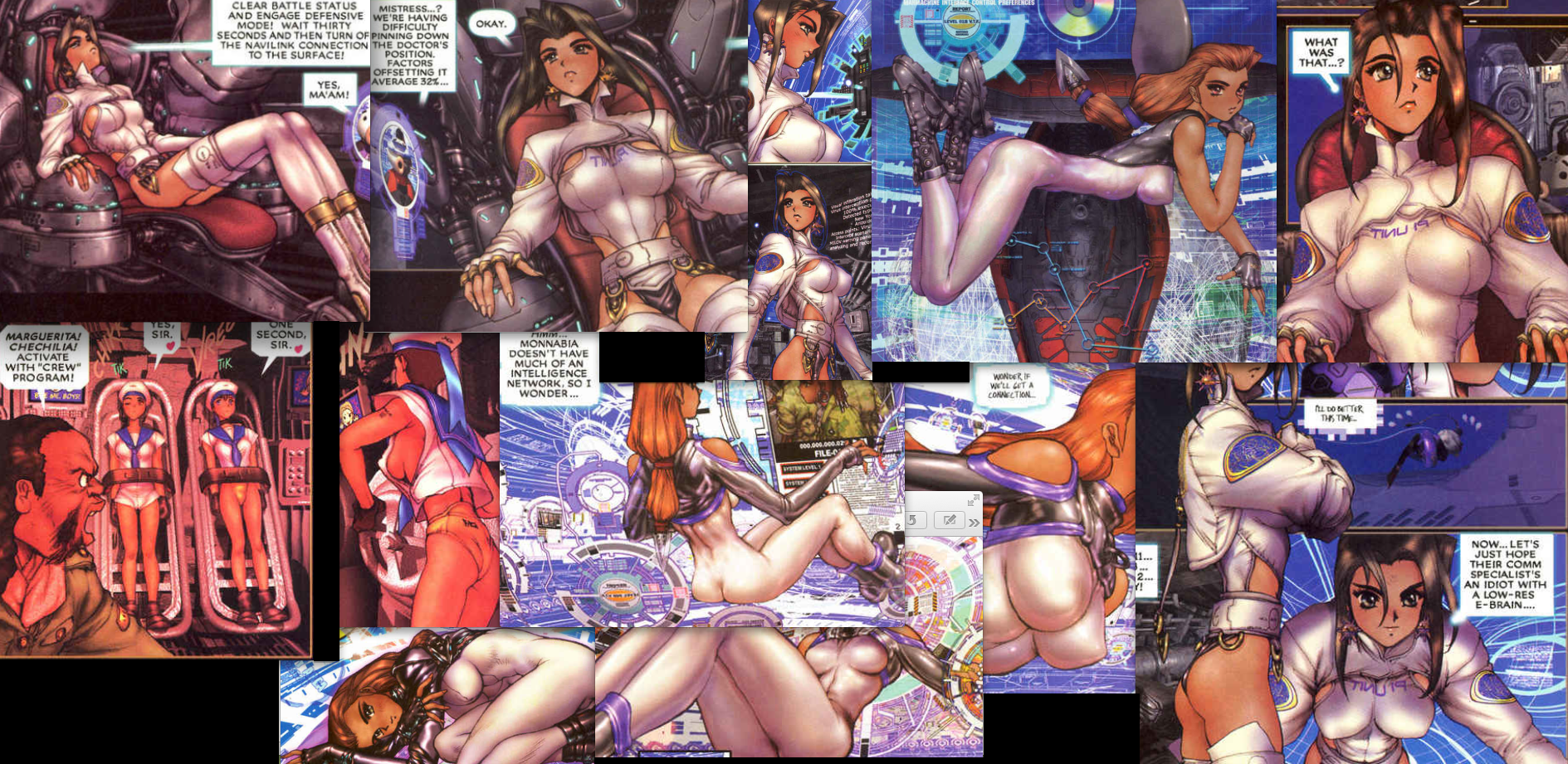


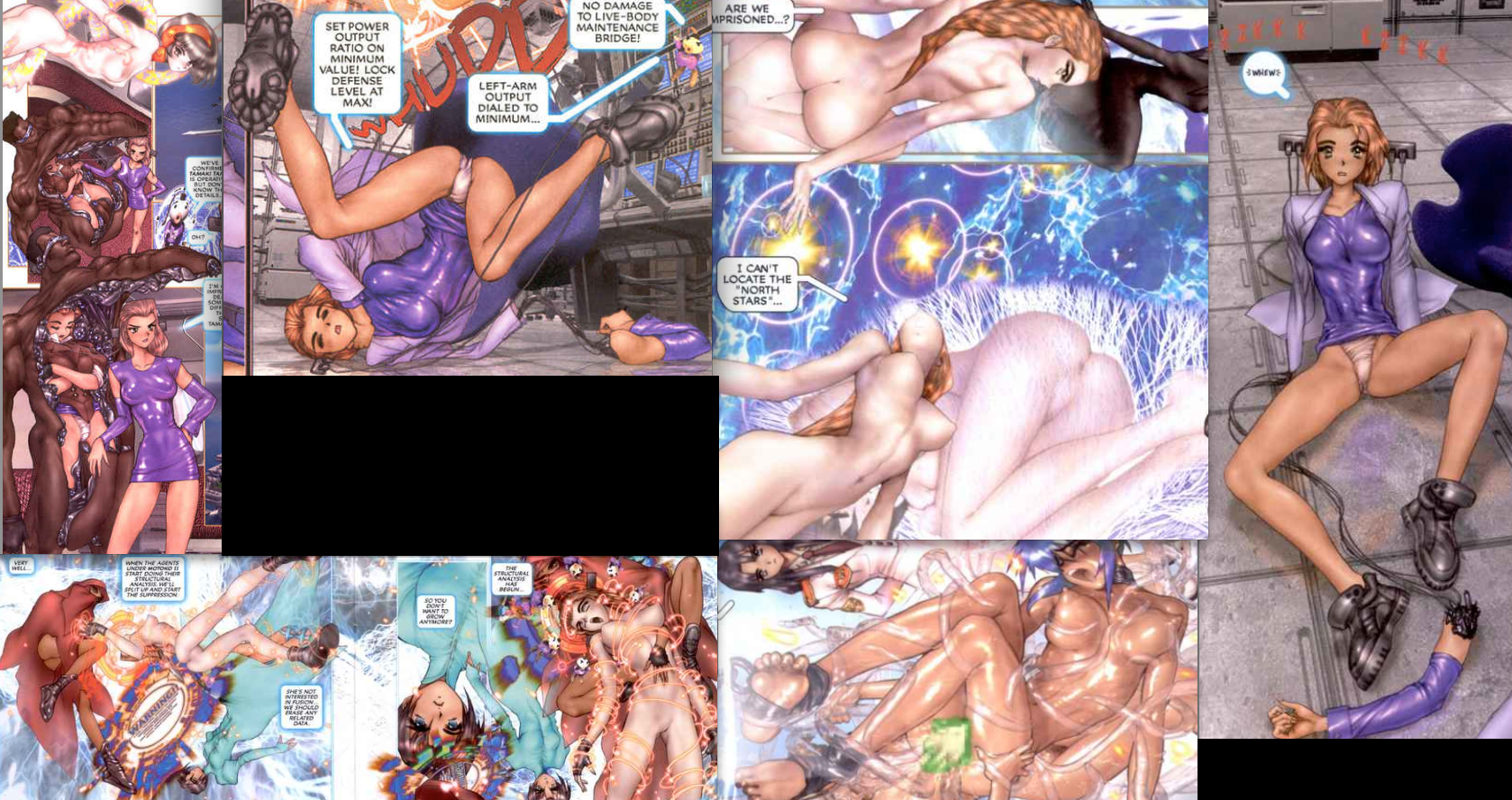





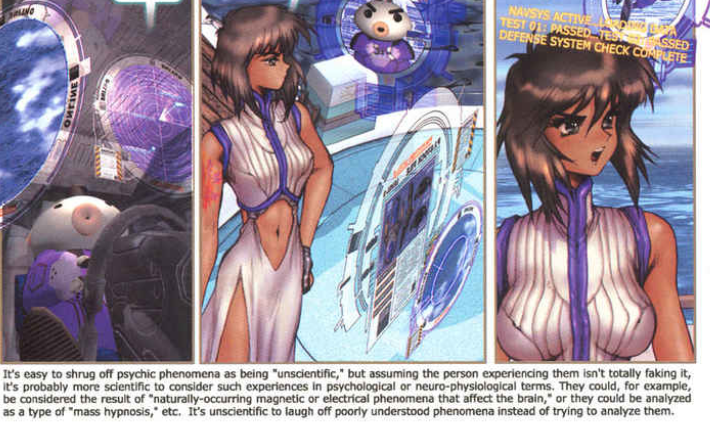


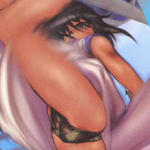
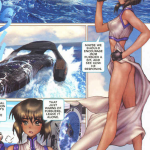

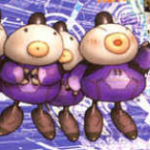

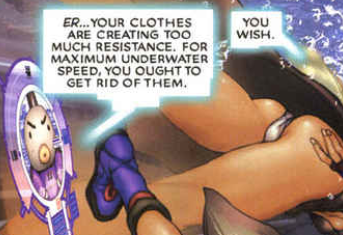



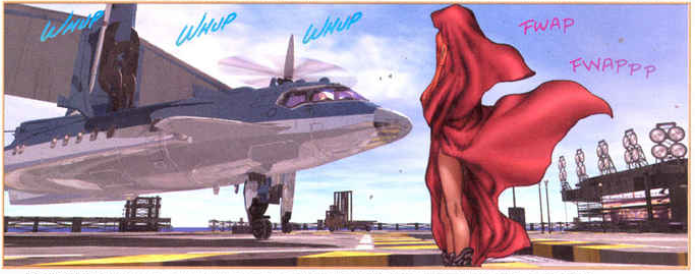
Thank you very much for bringing light to these panels! I absolutely love Masamune Shirow’s work, and your article is amazing!
Masamune Shirow is actually one of the saddest examples of manga artists that fell from greatness right into the very depths of porn hell :(((
Most of the artists I knew over the years, regardless of their gender, occasionally drew some sort of light or less-than-light pornography, as an expression of their sexual tastes and energies, but it seems that Masamune Shirow’s sexual energy managed to effectively keep him from ever publishing a decent manga after the original Koukaku Kidoutai.
Damn, I just bought this manga blindly because I liked 1 and 1.5.
D: Oh God, what happened to these series D: ? [EDIT: Bad things to see] on almost every page. And so tasteless D: .
I just find it revolting. I’m 1/3 through it and I have to sell it because I can’t stand a page more of this filth.
I don’t understand what’s the point of this manga. Why didn’t he make a hentai manga if he wanted to draw something sexual instead of ruining one of the few good cyberpunk mangas D: .
Hi, I’ve really been enjoying this series, and your very detailed, incisive analysis.
Even though there was much in how the Ghost in the Shell manga depicted women that made me cringe, I had been cutting Shirow a lot of slack, simply because I really liked early Appleseed. Then I bought Man Machine Interface, and I simply could not get past the first dozen pages. The gibbering pseudo-philosophy, the cutesy little octopus remotes, the bad writing…and above all his depiction of women. Beyond even the objectification and massively sexist portrayals, it was like he was drawing them from a third-hand description, like medieval scholars trying to describe rhinoceroses and giraffes.
I really feel like ghost in the Shell could have an interesting dialogue about what it means to be human when people can be so heavily cyborgized, and even about gender in the absence of biology. But if Shirow fails so hard at basic depictions of cis women, I can’t see him being able to do more.
Thanks! There’s a final part coming, I’m just sort of fried re: cyberbodies.
“from a third-hand description, like medieval scholars trying to describe rhinoceroses and giraffes.”
*nodding thoughtfully* (haha!)
The original manga ends with Batou being over-shocked at the PuppetMajor’s new body having a penis as well as a pretty face and long hair, actually, so you’re probably quite right. This is good, though
Pardon my language, but… To be honest, MMI is bullshit. Pure first class bullshit. In this manga, Shirow’s literally insulted his watchers for attracting some lecherous, idiotic waif’s.
This is my opinion at least.
Amen